MONTEREY COUNTY HIGHLIGHTS:
January-June 2001
These highlights chronicle the first half of the year 2001. They were
created incrementally and reposted as new photos were available so the
year runs generally "backwards" on this page. The abbreviation
"MTY" means "Monterey County" in the text below. Text by Don Roberson.
Photos on this page are copyrighted by the photographers to whom they are
attributed, and may not be reproduced in any form (including
other web sites) without the express consent of the photographer.
This was such a fine year that its now been divided into two
separate pages. This page covers January through June. Another page covers
July
through December 2001.
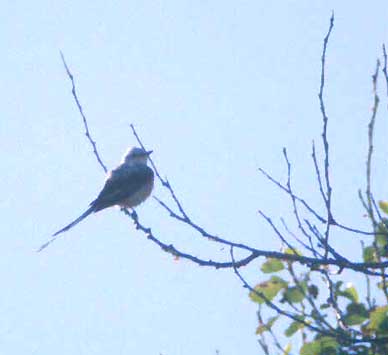 An
influx of vagrants of generally southeastern origin which began in mid-May
continued well into June with a number of exciting discoveries. The best
was a singing male Blue-winged Warbler at
Big Sur R. mouth 9 June (Don Roberson), a third MTY record (and the first
ever to appear here in spring). Almost as impressive was a Scissor-tailed
Flycatcher there 16 June (Rita Carratello, Don Roberson; photo
right © 2001 by Don Roberson), the first photographed in MTY since
Oct 1992. Other finds of note in Andrew Molera State Park at Big Sur R.
mouth in June were yet another singing White-eyed
Vireo 11 June (Rick Fournier), a singing Hooded
Warbler 5 June (Jason Scott), singing Black-and-white
Warbler 10 June (mob), singing Palm Warbler
11 June (Rick Fournier), and singing American Redstart
9 June (Steve Rovell). BSOL banded two Rose-breasted
Grosbeaks 15-16 June and there was a Great-tailed Grackle there
5 June (Jason Scott). The Carmel R. mouth hosted a singing Chestnut-sided
Warbler 14 June (Rick Fournier) and a singing Hooded
Warbler 11-13 June (Jason Scott, Bill Hill).
An
influx of vagrants of generally southeastern origin which began in mid-May
continued well into June with a number of exciting discoveries. The best
was a singing male Blue-winged Warbler at
Big Sur R. mouth 9 June (Don Roberson), a third MTY record (and the first
ever to appear here in spring). Almost as impressive was a Scissor-tailed
Flycatcher there 16 June (Rita Carratello, Don Roberson; photo
right © 2001 by Don Roberson), the first photographed in MTY since
Oct 1992. Other finds of note in Andrew Molera State Park at Big Sur R.
mouth in June were yet another singing White-eyed
Vireo 11 June (Rick Fournier), a singing Hooded
Warbler 5 June (Jason Scott), singing Black-and-white
Warbler 10 June (mob), singing Palm Warbler
11 June (Rick Fournier), and singing American Redstart
9 June (Steve Rovell). BSOL banded two Rose-breasted
Grosbeaks 15-16 June and there was a Great-tailed Grackle there
5 June (Jason Scott). The Carmel R. mouth hosted a singing Chestnut-sided
Warbler 14 June (Rick Fournier) and a singing Hooded
Warbler 11-13 June (Jason Scott, Bill Hill).
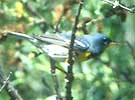 Several singing male
Northern Parula
Parula
americana returned to the Big Sur R. mouth area by late April; this
species has bred here the last three years. Two males studied at close
range were unbanded; you can see this for yourself on this photo of the
male on territory around the main Andrew Molera SP parking lot (photo
left 9 June 2001 © Don Roberson). Assuming this is a returning
male from last summer, it must be the male from the "complex" banding area
across the bridge from the parking lot because he was not banded (but last
year's female -- his mate -- was netted and banded). The male that had
territory in the sycamores near BSOL last year was banded; this year's
bird (the one in the photo) is not.
Several singing male
Northern Parula
Parula
americana returned to the Big Sur R. mouth area by late April; this
species has bred here the last three years. Two males studied at close
range were unbanded; you can see this for yourself on this photo of the
male on territory around the main Andrew Molera SP parking lot (photo
left 9 June 2001 © Don Roberson). Assuming this is a returning
male from last summer, it must be the male from the "complex" banding area
across the bridge from the parking lot because he was not banded (but last
year's female -- his mate -- was netted and banded). The male that had
territory in the sycamores near BSOL last year was banded; this year's
bird (the one in the photo) is not.
An early push of southern vagrants was noted in early-to-mid May. The
most exciting were a Zone-tailed Hawk
Buteo
albonotatus migrating north over Big Sur R. mouth 10 May 2001 (Craig
Hohenberger), a first MTY record! [Another Zone-tailed Hawk that
reached Marin County earlier that week was the first for northern California.]
Other MTY highlights were an Ovenbird
Seiurus
aurocapillus and a Hooded Warbler
Wilsonia
citrina banded by BSOL 18 May, a singing White-eyed
Vireo Vireo griseus at Big Sur R. mouth on 16 May (Jason
Scott), and a singing Yellow-throated Vireo
V.
flavifrons there on 19 May (Steve Rovell, m.ob.), and a Rose-breasted
Grosbeak 10 May and an Indigo Bunting
23 May (both netted by BSOL). Late May vagrants were a Baltimore
Oriole at Big Sur R. mouth (fide Jeff Davis) and a Palm
Warbler at Pt. Pinos (Don Roberson), both on 30 May.
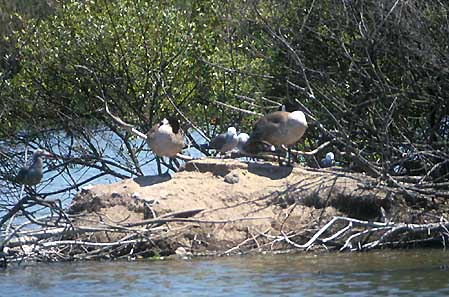 By
spring 2001 up to four pairs of Heermann's Gulls
Larus
heermanni were frequenting Roberts Lake where this species nested the
last two summers. Pairs were copulating in April and two adults appeared
to be on eggs by mid-May. By June, however, all nesting attempts appeared
to be abandoned. This may be because of the pressure of the exploding population
of Canada Geese. This non-native population has been increasing in exponential
numbers; up to 188 were on Roberts Lake by mid-June. Some of these have
taken to roosting on the nesting islets (right; photo © 2001 D. Roberson)
and may have forced the nesting gulls to abandon their eggs.
By
spring 2001 up to four pairs of Heermann's Gulls
Larus
heermanni were frequenting Roberts Lake where this species nested the
last two summers. Pairs were copulating in April and two adults appeared
to be on eggs by mid-May. By June, however, all nesting attempts appeared
to be abandoned. This may be because of the pressure of the exploding population
of Canada Geese. This non-native population has been increasing in exponential
numbers; up to 188 were on Roberts Lake by mid-June. Some of these have
taken to roosting on the nesting islets (right; photo © 2001 D. Roberson)
and may have forced the nesting gulls to abandon their eggs.
Migrant geese in May are quite late but several made news this spring.
A wintering Ross's Goose Chen rossii
at Crespi Pond lingered to 2 May; a "Cackling" Canada
Goose Branta canadensis minima was still at El Estero through
20 May (perhaps the same minima present off-and-on all winter since
last September?), and an apparent "Aleutian Canada
Goose" B. c. leucopareia was at Carmel R. mouth 13-19 May
(B. Hill +). This latter taxa had been on the Endangered Species list until
delisted this spring; there are now 7 records for MTY. Bill Hill photographed
these two small Canada Geese this May (below). It is interesting
to compare the "Aleutian" (below left) with a "Cackling" (below right);
a discussion follows:
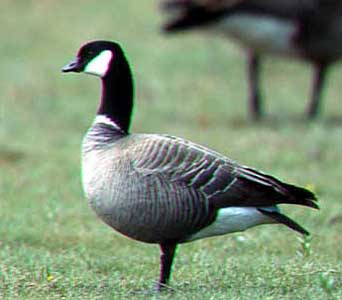
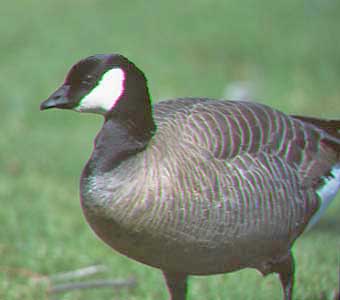
Of course leucopareia has a white neck ring at the base of the neck
but some minima also show this feature (e.g., Crespi Pond 19-29
Oct 1996). The Carmel R. mouth bird was identified as leucopareia
because of its paler breast & flank color, a slightly larger overall
size, a slightly longer bill (which seemed more apparent in the field than
in this shot) and by head shape. The Sibley (2000) field guide contrasts
the "squarer head" of "Aleutian" with the "rounded head" of "Cackling."
My field notes from the Arcata bottoms, Humboldt Co., in April 1996 of
two birds side-by-side described a "flatter crown" to the "Cackling" but
a "very steep forehead" to the "Aleutian" as well as noting the "Aleutian's"
slightly larger size, longer bill, and paler breast. Real differences in
head shape are shown in Bill Hill's shots. The "Aleutian" has a very steep
forehead and a very steeply-angled downturn at the nape. The "Cackling's"
head shape is more blocky without these steep angles but the top of crown
is flat (yet the overall impression at a distance is "rounded").
Undoubtedly the best bird of the winter was a Greater
Shearwater
Puffinus gravis not far off Pt. Pinos in Monterey
Bay on 13 Jan 2001. Found by Richard Ternullo as he skippered the Monterey
Bay Whale Watch boat, the shearwater was loosely associated with a
pod of Long-beaked Common Dolphins. Aboard were three birders from Utah
-- Bill & Cheryl Schreir and Erik Hendrickson -- who supplied good
written details. Presumably the same individual was seen two days later,
near the same spot, on a Shearwater Journeys boat by Scott & Linda
Terrill, Debi Shearwater and others. This is now the 3rd record in Monterey
Bay -- these are the only three records from the entire North Pacific!
Remarkably, two have been in winter: this bird and one described by a boatload
of birders on 24 Feb 1979.
On land, perhaps the most interesting wintering individual was:
14-28 Jan 2001
Hammond's Flycatcher Empidonax hammondii at Carmel R. mouth
Photos Jan 2001 © 2001 Bill Hill (left two) &
D. Roberson (righthand poor shot)

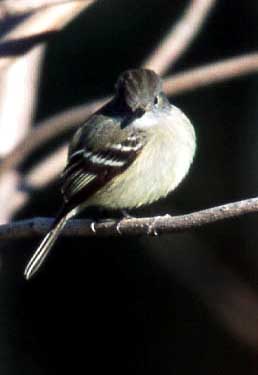
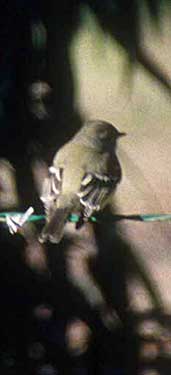
This is only the fourth Hammond's Flycatcher to winter in Monterey
County, and the first to be well photographed (an exceptional series by
Bill Hill; more can be seen on Bill
Hill's web site). Note the short-tailed, big-headed appearance; the
fresh plumage in early winter; the gray head/green back contrast; the grayish-white
throat; the very short and narrow bill; and the very long primary extension.
The bird was also tiny and an active tail & wing flicker. About 2/3
of the lower mandible was pale which is more than is typical in Hammond's
but was well within the known range of variation.
Elsewhere, two local highlights were wintering birds first found in
late 2000:


A juvenal-plumaged Yellow-billed Loon Gavia adamsii
was a half-mile off Lovers Pt., Pacific Grove, from at least 18 Jan 2000-15
Jan 2001. This fine photo (left) was taken by Clay Kempf during the Monterey
Peninsula Christmas Bird Count on 29 Dec 2000 (photo © 2001 Clay Kempf,
used with permission). It was in the same general location as frequented
by an adult Yellow-billed Loon first discovered in basic plumage in Dec
1993. That bird returning the following five years in full breeding plumage
(7 Nov 1994, 10 Nov 1995, missed by birders in 1996, returned again 30
Oct 1997 and 24 Nov 1998), molted in basic plumage during Nov-Dec, and
then molted back into alternate plumage in early March, lingering as late
as 28 Mar 1999 (R. Ternullo). Since this winter's bird was in juvenal plumage
it is a different loon than our previous long-visiting adult "banana-bill."
Also of significance were up to six (!) Long-tailed Ducks
Clangula
hyemalis in Moss Landing harbor. The distant photo (above; © 2001
D. Roberson) shows three of them: a male and two immatures (plus a sleeping
Surf Scoter off to the right). We had just started to get used to the name
change from "Oldsquaw" to the internationally used Long-tailed Duck and
here were unprecedented local numbers! The sequence started with one on
18 Nov 200, three on 22 Nov, five (including an adult male) by 15 Dec,
six (now two adult males) on 26 Dec and into early Jan 2001, down to five
on 30 Jan, and three in February. This is more Long-tailed Ducks in one
MTY location than at any previously recorded time. There were four in Moss
Landing harbor on 25 Feb 1961; four more that moved between Moss Landing
and the Pajaro R. mouth in winter 1985-86; and four together off Ft. Ord
on 11 Feb 1999 (located by a research boat observer; summaries of older
records in Roberson (1985) and newer records from Monterey Birds
2d ed., in progress).
Literature cited:
Roberson, D. 1985. Monterey Birds. Monterey Pen. Audubon Soc.,
Carmel, CA.
Sibley, D. A. 2000. National Audubon Society's The Sibley Guide to Birds.
Alfred A. Knopf, New York.
TOP
GO TO HIGHLIGHTS
FROM SECOND HALF OF 2001
BACK TO MONTEREY
COUNTY PAGE
GO TO HIGHLIGHTS
FROM 1999
GO TO HIGHLIGHTS
FROM 2000
GO TO HOME PAGE
GO TO
IDENTIFICATION PAGE
GO TO BIRDING THE
WORLD PAGE
GO TO BIRD FAMILIES
OF THE WORLD
Page initiated 28 Feb 2001, last updated 8 Oct 2001
 Several singing male
Northern Parula
Parula
americana returned to the Big Sur R. mouth area by late April; this
species has bred here the last three years. Two males studied at close
range were unbanded; you can see this for yourself on this photo of the
male on territory around the main Andrew Molera SP parking lot (photo
left 9 June 2001 © Don Roberson). Assuming this is a returning
male from last summer, it must be the male from the "complex" banding area
across the bridge from the parking lot because he was not banded (but last
year's female -- his mate -- was netted and banded). The male that had
territory in the sycamores near BSOL last year was banded; this year's
bird (the one in the photo) is not.
Several singing male
Northern Parula
Parula
americana returned to the Big Sur R. mouth area by late April; this
species has bred here the last three years. Two males studied at close
range were unbanded; you can see this for yourself on this photo of the
male on territory around the main Andrew Molera SP parking lot (photo
left 9 June 2001 © Don Roberson). Assuming this is a returning
male from last summer, it must be the male from the "complex" banding area
across the bridge from the parking lot because he was not banded (but last
year's female -- his mate -- was netted and banded). The male that had
territory in the sycamores near BSOL last year was banded; this year's
bird (the one in the photo) is not.
 An
influx of vagrants of generally southeastern origin which began in mid-May
continued well into June with a number of exciting discoveries. The best
was a singing male Blue-winged Warbler at
Big Sur R. mouth 9 June (Don Roberson), a third MTY record (and the first
ever to appear here in spring). Almost as impressive was a Scissor-tailed
Flycatcher there 16 June (Rita Carratello, Don Roberson; photo
right © 2001 by Don Roberson), the first photographed in MTY since
Oct 1992. Other finds of note in Andrew Molera State Park at Big Sur R.
mouth in June were yet another singing White-eyed
Vireo 11 June (Rick Fournier), a singing Hooded
Warbler 5 June (Jason Scott), singing Black-and-white
Warbler 10 June (mob), singing Palm Warbler
11 June (Rick Fournier), and singing American Redstart
9 June (Steve Rovell). BSOL banded two Rose-breasted
Grosbeaks 15-16 June and there was a Great-tailed Grackle there
5 June (Jason Scott). The Carmel R. mouth hosted a singing Chestnut-sided
Warbler 14 June (Rick Fournier) and a singing Hooded
Warbler 11-13 June (Jason Scott, Bill Hill).
An
influx of vagrants of generally southeastern origin which began in mid-May
continued well into June with a number of exciting discoveries. The best
was a singing male Blue-winged Warbler at
Big Sur R. mouth 9 June (Don Roberson), a third MTY record (and the first
ever to appear here in spring). Almost as impressive was a Scissor-tailed
Flycatcher there 16 June (Rita Carratello, Don Roberson; photo
right © 2001 by Don Roberson), the first photographed in MTY since
Oct 1992. Other finds of note in Andrew Molera State Park at Big Sur R.
mouth in June were yet another singing White-eyed
Vireo 11 June (Rick Fournier), a singing Hooded
Warbler 5 June (Jason Scott), singing Black-and-white
Warbler 10 June (mob), singing Palm Warbler
11 June (Rick Fournier), and singing American Redstart
9 June (Steve Rovell). BSOL banded two Rose-breasted
Grosbeaks 15-16 June and there was a Great-tailed Grackle there
5 June (Jason Scott). The Carmel R. mouth hosted a singing Chestnut-sided
Warbler 14 June (Rick Fournier) and a singing Hooded
Warbler 11-13 June (Jason Scott, Bill Hill).
 By
spring 2001 up to four pairs of Heermann's Gulls
Larus
heermanni were frequenting Roberts Lake where this species nested the
last two summers. Pairs were copulating in April and two adults appeared
to be on eggs by mid-May. By June, however, all nesting attempts appeared
to be abandoned. This may be because of the pressure of the exploding population
of Canada Geese. This non-native population has been increasing in exponential
numbers; up to 188 were on Roberts Lake by mid-June. Some of these have
taken to roosting on the nesting islets (right; photo © 2001 D. Roberson)
and may have forced the nesting gulls to abandon their eggs.
By
spring 2001 up to four pairs of Heermann's Gulls
Larus
heermanni were frequenting Roberts Lake where this species nested the
last two summers. Pairs were copulating in April and two adults appeared
to be on eggs by mid-May. By June, however, all nesting attempts appeared
to be abandoned. This may be because of the pressure of the exploding population
of Canada Geese. This non-native population has been increasing in exponential
numbers; up to 188 were on Roberts Lake by mid-June. Some of these have
taken to roosting on the nesting islets (right; photo © 2001 D. Roberson)
and may have forced the nesting gulls to abandon their eggs.




